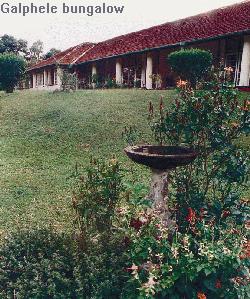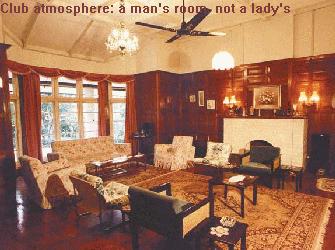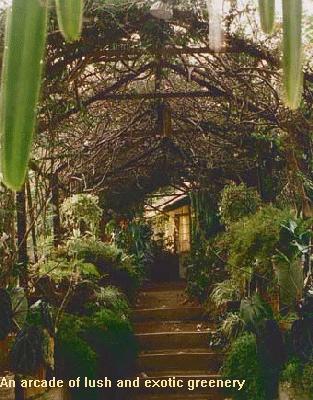

![]()

 Perhaps
fortunately for the planters who reside in them, most plantation bungalows are
located off the main road, so visits by friends of friends who happen to be
passing and drop in to look around, do not happen every day.
Perhaps
fortunately for the planters who reside in them, most plantation bungalows are
located off the main road, so visits by friends of friends who happen to be
passing and drop in to look around, do not happen every day.
Yet it never fails to amaze me that every bungalow we have visited for this series seems to be permanently on display, ready for unexpected visitors.
It is one of those endearing traditions that has remained from the days when a planter kept his home and guest rooms ready so that fellow planters making the rounds of tea estates would be welcomed. With poor communications it was sometimes difficult to inform a planter of one’s visit in advance, so planters became accustomed to hosting visitors at short notice.
Even so, living in a bungalow that is an unofficial rest house for passing acquaintances could be an inconvenience in this modern, inhospitable age. Not in the hills. When that intrepid bungalow hunter and walking Ferguson’s Directory, Michael Cooke of Kandy, led us without an invitation or advance warning to Galphele Bungalow, we were received with utmost courtesy by the occupants, Mr & Mrs Nihal Ratwatte.
We had been enticed to disturb them by the long loggia lined with plants, an arcade of lush and exotic greenery, that ascended by gentle steps to the bungalow’s entrance. Here was an addition to the bungalow created by a previous planter (or his wife?) and lovingly maintained by succeeding planters who cared.
It gives access to an entrance hall that was probably not part of the bungalow’s original design. It seems to have been added as a second thought to a bungalow that consists mainly, and attractively, of rambling galleries flanked by bold Doric columns.
The main verandah fronts four bedrooms and overlooks the bungalow’s well-maintained garden and lawn with its ancient bird bath. The verandah wraps around as a gallery along the back of the length of the house, by the service quarters.
Here is a bungalow that has been designed for its location, not from an imported plan. Its origins date from 1912 and up to the 1970s it was privately owned. Then the plantation consisted of 1,011 acres exclusively in tea, although earlier there had also been a few acres of rubber.
The bungalow is situated at about 1,700 feet above sea level. It is only four miles from the Wattegama railway station, on the Kandy- Matale line.
 Visitors
pass from the entrance hall to the sheer delight of a sitting room bedecked in
teak panels and a rich, wooden parquet flooring. Of course, it’s too
elaborate for contemporary taste, but the beautifully maintained wooden panels
create the exact comfort and security a planter would crave after a day’s
work. It has an undeniable club atmosphere; it is a man’s room, not a lady’s.
You can almost hear the convivial chatter and loud guffaws of planters meeting
in the evenings, while the wives nattered elsewhere. Yet it is a family room
too, made more cosy by a log fire in the brick built grate. French windows lead
from it to the garden.
Visitors
pass from the entrance hall to the sheer delight of a sitting room bedecked in
teak panels and a rich, wooden parquet flooring. Of course, it’s too
elaborate for contemporary taste, but the beautifully maintained wooden panels
create the exact comfort and security a planter would crave after a day’s
work. It has an undeniable club atmosphere; it is a man’s room, not a lady’s.
You can almost hear the convivial chatter and loud guffaws of planters meeting
in the evenings, while the wives nattered elsewhere. Yet it is a family room
too, made more cosy by a log fire in the brick built grate. French windows lead
from it to the garden.
The dining room adjoins the sitting room and then there is a corridor of bedrooms. These have none of the flamboyance of the sitting room and whatever traditional furniture there may have been, has been replaced by basic pieces more functional than pretty.
Nevertheless the rooms are meticulously well kept, confirming that the plantation tradition of hospitality still flourishes at Galphele.
A link with former planting days has been preserved in at least one of the bathrooms. The bathtub is in the room’s centre with a shower curtain strung around it that gives it the appearance of a four-poster bed. Perhaps it wasn’t intentional but it fits in with the aura of the house.
It is not solely money that keeps a bungalow in fine fettle; occupants who are house-proud are essential too. Galphele is lucky. Although it could not truthfully be classed as one of the country’s best bungalows, it has charm due to the dedication of its present occupants. They have made it a pleasure, even for unexpected visitors like ourselves, to drop in and look around.
Continue to Plus page 14 - The twilight village
Return to the Plus contents page
![]()
| HOME PAGE | FRONT PAGE | EDITORIAL/OPINION | NEWS / COMMENT | BUSINESS
Please send your comments and suggestions on this web site to
info@suntimes.is.lk or to
webmaster@infolabs.is.lk